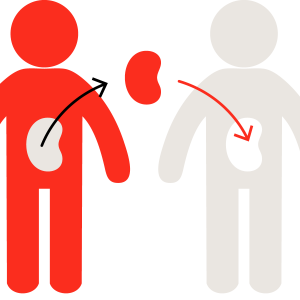The organs start functioning quickly patients life expectancies. Qualified expenses include reimbursement of travel lodging meals and incidentals lost.
 Kidney Donors Get Job Security Transplantfirst Organ Donors Get Job Protection
Kidney Donors Get Job Security Transplantfirst Organ Donors Get Job Protection
However acceptable ages may vary by transplant center and the health of the donor candidate.

Living organ donation. What are the types of living donor transplants. Get Results from 6 Engines at Once. Living donor kidney transplantation accounts for 98 of activity.
A healthy person can lead a normal life with only one functioning kidney and therefore they are able to donate the other to help someone in need of a kidney transplant. Living donor transplantation is practised in adult and paediatric settings and both liver and kidneys are transplanted. Get Results from 6 Engines at Once.
Ad Search Donation Hospital. A living liver donor is a person who gives part of their liver to someone with liver failure who needs a transplant the recipient. Part of a liver can also be transplanted from a living donor to help someone in need of a liver transplant.
A living donor is someone who donates a kidney or partial liver to another person who has end-stage kidney disease or liver failure. Ad Search Donation Hospital. Donating an organ anonymously to whomever is the best medical match is often referred to as altruistic living donation.
The most commonly donated organ by a living person is a kidney. Kidney donation is the most common. This could be a friend or family member or someone they do not already know.
Typically living people can only donate a kidney or part of their liver according to Dr. The kidney is the most commonly transplanted organ from a living donor. Living organ donors are a valuable and essential resource for patients in need of kidneys livers and other lifesaving organs and tissues.
October 26 2020. In the UK latest statistics show that 39 of all organ donors are living donors and living donor transplantation represents 21 of total transplant activity. The donor candidate is carefully evaluated by lab.
What is a living organ donation. The prospective donor must have several points of compatibility including a compatible blood type tissue type and other markers. Living Organ Donation Reimbursement Program formerly Reimbursement of Travel and Subsistence Expenses toward Living Organ Donation Program is a national program that provides financial assistance for people who wish to be living organ donors but might otherwise not be able to donate.
Living donors can be. Living organ donation is exceptionally generous and altruistic and has been repeatedly described as perhaps the most meaningful act that one human can carry out for another. Its far less common to sign up to be a living organ donor.
Living liver donation where a segment of the donors liver is transplanted occurs less often and the donor is usually related to the recipient. For the recipient there are many benefits to living donation including a shorter wait for an organ convenient scheduling of surgeries and fewer complications and procedures including dialysis for a kidney. One entire kidney is removed and transplanted.
Living organ donors are usually between the ages of 18 and 60 year old. Most qualifying donors however are able to. Adequate information on outcomes important to donors may take many years to ascertain and may be evident only by comparing large numbers of donors with suitable controls.
A liver transplant operation is life-saving surgery for patients with end stage liver disease. Living donation which dates back nearly 60 years should be considered carefully due to the risks both during surgery and later in life. A blood relative of the person parents siblings adult children someone who is not related by blood but knows the person like a.
In the setting of an overall decline in living organ donation and new questions about long-term safety a better understanding of outcomes after living donation has become imperative. Removing barriers to living organ donation prohibiting certain discrimination in insurance and codifying protection for living donors under the Family and Medical Leave Act FMLA is critical and. A living donation occurs when a person who is alive donates an organa liver or a kidneyso that it can be transplanted into someone who needs it.
Medstar Georgetown University Hospital transplant nurse Allie Hayes has seen the benefits of living donation firsthand.
